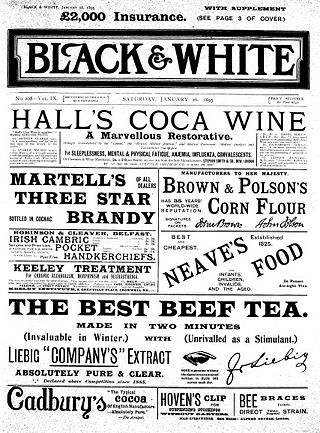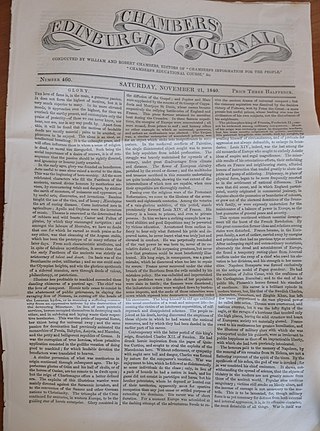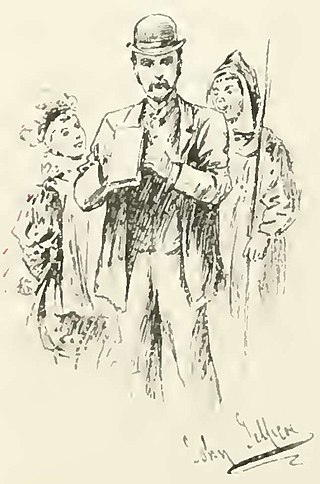
Mary Elizabeth Braddon was an English popular novelist of the Victorian era. She is best known for her 1862 sensation novel Lady Audley's Secret, which has also been dramatised and filmed several times.

Penny dreadfuls were cheap popular serial literature produced during the 19th century in the United Kingdom. The pejorative term is roughly interchangeable with penny horrible, penny awful, and penny blood. The term typically referred to a story published in weekly parts of 8 to 16 pages, each costing one penny. The subject matter of these stories was typically sensational, focusing on the exploits of detectives, criminals, or supernatural entities. First published in the 1830s, penny dreadfuls featured characters such as Sweeney Todd, Dick Turpin, Varney the Vampire, and Spring-heeled Jack.

Illustrated fiction is a hybrid narrative medium in which images and text work together to tell a story. It can take various forms, including fiction written for adults or children, magazine fiction, comic strips, and picture books.

Ellen Price was an English novelist better known as Mrs. Henry Wood. She is best remembered for her 1861 novel East Lynne. Many of her books sold well internationally and were widely read in the United States. In her time, she surpassed Charles Dickens in fame in Australia.

A light novel is a style of young adult fiction in the form of a novel primarily targeting high school and middle school students. The term "light novel" is a wasei-eigo, or a Japanese term formed from words in the English language. Light novels are often called ranobe (ラノベ) or, in English, LN. The average length of a light novel is about 50,000 words, and is published in the bunkobon format. Light novels are subject to dense publishing schedules, with new installments being published in 3–9-month intervals.

Frances Browne was an Irish poet and novelist, best remembered for her collection of short stories for children, Granny's Wonderful Chair.

In literature, a serial is a printing or publishing format by which a single larger work, often a work of narrative fiction, is published in smaller, sequential instalments. The instalments are also known as numbers, parts, fascicules or fascicles, and may be released either as separate publications or within sequential issues of a periodical publication, such as a magazine or newspaper.

The London Journal; and Weekly Record of Literature, Science and Art was a British penny fiction weekly, one of the best-selling magazines of the nineteenth century.
James Robert Hogg was a Scottish publisher.

Black and White: A Weekly Illustrated Record and Review was a British Victorian-era illustrated weekly periodical founded in 1891 by Charles Norris Williamson. In 1912, it was incorporated with The Sphere.

Ella Hepworth Dixon was an English author and editor. Her best-known work is the New Woman novel The Story of a Modern Woman, which has been reprinted in the 21st century.
Elizabeth Caroline Grey (1798–1869), aka Mrs. Colonel Grey or Mrs. Grey, was a prolific English author of over 30 romance novels, silver fork novels, Gothic novels, sensation fiction and Penny Dreadfuls, active between the 1820s and 1867. There is some controversy about the details of her life story, and if she actually authored any penny dreadfuls.

Chambers's Edinburgh Journal was a weekly 16-page magazine started by William Chambers in 1832. The first edition was dated 4 February 1832, and priced at one penny. Topics included history, religion, language, and science. William was soon joined as joint editor by his brother Robert, who wrote many of the articles for the early issues, and within a few years the journal had a circulation of 84,000. From 1847 to 1849 it was edited by William Henry Wills. In 1854 the title was changed to Chambers's Journal of Popular Literature, Science, and Art, and changed again to Chambers's Journal at the end of 1897.
Camilla Dufour Crosland was an English writer of fiction, poetry, essays and sketches. She also translated some plays and poetry by Victor Hugo.
Annie Edwards, also known as Annie Edwardes, was a popular English novelist in the Victorian era. Three of her 21 books were adapted for the theatre. Perhaps her best-known work is her 1866 novel, Archie Lovell, which the playwright F. C. Burnand adapted in 1874.

The Leisure Hour was a British general-interest periodical of the Victorian era which ran weekly from 1852 to 1905. It was the most successful of several popular magazines published by the Religious Tract Society, which produced Christian literature for a wide audience. Each issue mixed multiple genres of fiction and factual stories, historical and topical.
John Archibald Webb (1866–1947) was a British painter and illustrator who illustrated over 150 books.

John Timothy Jellicoe was a British illustrator who produced large number of illustrations for newspapers and magazines as well as illustrating books and stories by a wide range of authors.
Sunday reading was a genre of periodical popular in Victorian Britain which offered light Christian reading thought to be suitable for families to read at home on Sundays. Typical examples such as Sunday at Home, The Quiver, and Leisure Hour featured a mixture of fiction, non-fiction, and verse, all dealing in some way with Christian themes.

Sunday at Home was a weekly magazine published in London by the Religious Tract Society beginning in 1854. It was one of the most successful examples of the "Sunday reading" genre of periodicals: inexpensive magazines intended to provide wholesome religious entertainment for families to read on Sundays, especially as a substitute for "pernicious" secular penny weeklies such as The London Journal or The Family Herald.














